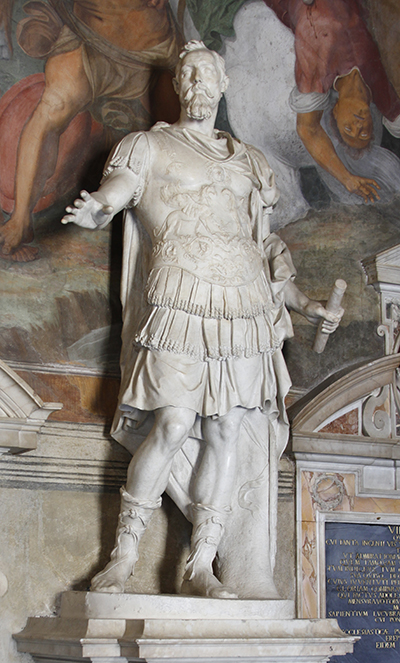Gian Lorenzo Bernini designed three objects for the memorials to Carlo Barberini; a plaque to be sited at the entrance wall to the church Santa Maria in Aracoeli, a temporary catafalque in the same church, and a life-like statue, whose base material had been restored from an antique Roman statue, placed in the Palazzo dei Conservatori.
Carlo Barberini's brother had been a patron of Bernini (later to become Pope Urban VIII), and after Carlo's death Bernini designed his memorial. Carlo Barberini was a member of the papal military forces and it was customary to acknowledge death of the papal military at that time. Bernini was an acclaimed artist, sculptor and architect who was in high demand for his beautiful religious works in Rome.
This plaque designed and produced by Bernini uses a convex rounding of the shape to give an illusion of the figures as part of the plaque. The figures at the top of the design seem to naturally lay over the plaque and not stand out unnaturally. This is due to the rounding out of the plaque and allowing light to accentuate the figures. The detailed work on the figures, their natural poses and the natural flow of their garments are intricate work that Bernini produced for this plaque.
Bernini's pen and ink drawing shows a domed memorial with columns and statues for the temporary catafalque. This stood in the church of Santa Maria in Aracoeli. As the structure was temporary it did not survive as an historical relic. This catafalque stood for two weeks following the death of Carlo Barberini.
This statue was taken from a torso of Roman sculpture, possibly of Julius Caesar. Bernini produced the head alone and worked on other parts of this sculpture with Alessandro Algardi, such as the torso and garments. Algardi worked on the limbs. It was quite usual to take old statues and remodel them. This a large and monumental sculpture as a life-like figure for Carlo Barberini, dressed in armour and part of the papal military. All commanders or important people within the papal military would be memorialised like this. Carlo Barberini was the brother of the Urban VIII pope and a member of the papal military forces. This statue brings to life the soldier and the man, as part of his memorial with a large size statue.
Like most of Benini's other sculptural works, the figure is in a mobile position, holding a scroll in one hand and partially turning, holding out the other hand to appear to be starting to speak. This is typical of Bennito's style of making his figures not just appear life-like but to appear to be moving. Carlo Barberini was depicted as if giving advice or orders. He was a man in charge within the papal military forces in memorium.




